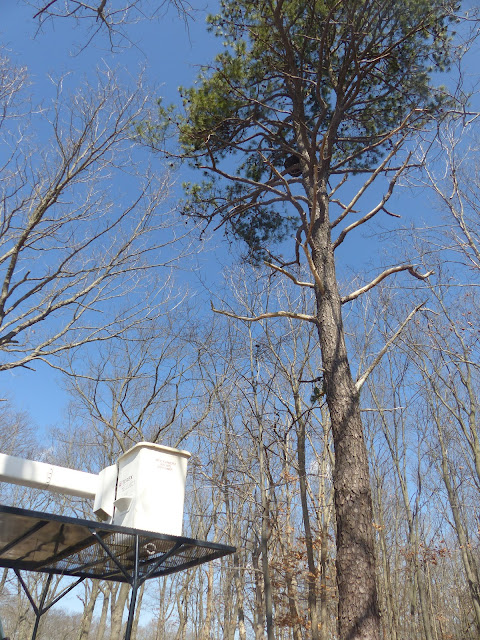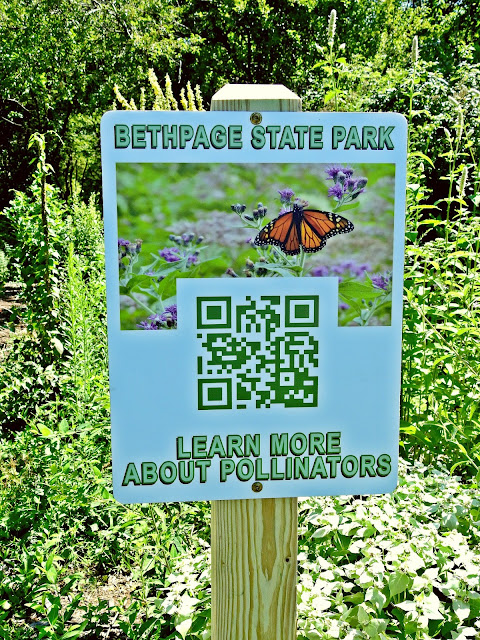A Wildlife Rescue Mission This Week on Our Black Course!
 As many of you may know, Bethpage State Park is prime habitat for Long Island's great horned owl population and here on the courses we do a great deal of work to ensure it stays that way!
As many of you may know, Bethpage State Park is prime habitat for Long Island's great horned owl population and here on the courses we do a great deal of work to ensure it stays that way!
Besides creating and installing nests for these magnificent predators (these owls ironically, do not build their own nests) we also monitor them regularly with a bucket truck into the treetops! Always at the forefront of this mission is our part-timer and raptor aficionado Jim Jones. Jim has kindly invited me to assist and be a part of this miraculous adventure yet again this year. Our joint goal is to oversee these beautiful birds grow, from egg to fully fledged over the course of the season. Similar to last year, we have a breeding owl pair utilizing the artificial nest built, just for them, on #7 of the Black Course.
As the ecologist for the park, there is nothing that brings me more joy than watching our resident owls care for their chicks and see that care aid their offspring's transformation, week to week, on our trips up to the nest. Below is this year's recently hatched owlet, about a week and a half old (left photo) and then again, about two weeks later (right photo).
This Tuesday, both Jim and I were very eager to see our growing chick (approximately 6 weeks after hatching) and snap a few pictures. This would perhaps be one of the last opportunities to do so (since the owlet will become increasingly active in the next few days), but when we reached the nest... it was already vacant!
Now this was not as alarming as one might think. The owlet IS entering the "branching" period of its life cycle. Branching refers to the time in which young owls will practice using their fully-developed talons and venture outside the nest onto surrounding tree branches. This is also around the same time that they get experimental and make small attempts at flying. With that in mind, Jim and I knew our young one could not be far and decided to do some seeking out.
However, after about 15 minutes of searching, we were then alarmed to see what appeared to be our young owl laying face down on the ground. While hanging out on the forest floor is not unlike these birds when branching, the position they take when doing so is usually upright on their feet. Very worried the owl may be injured (possibly by the nearby chain link fence) or worse, we rushed to the scene.
As we got closer we realized the young owl was still breathing...and that was a good sign. As Jim ran to get the bucket truck, I watch our little one intently, not taking my eyes of the bird for a second. I wanted to make sure the owlet remained calm and safe till Jim could get back.
In the process of waiting, I was relieved to see that the owl had turned his head around to stare right back with piercing eyes! Another great sign, that cognitively our owl could be fine.
The next step was to thoroughly and carefully check the owl out.
Now, I think its important to note here, that Jim is a wildlife professional. In an other situation, perhaps if a young owl is found in the woods and is not lying in a vulnerable position, we strongly encourage everyone to leave the owl alone. If there is cause for concern, tell a park employee or contact a local wildlife professional. Although you might not see the owl parents, there is a good chance they are close by and watching their offspring. Its also really important to refrain from getting close or interacting with a great horned owl, especially when young, because they can easily imprint on you. This is when the animal convinces itself you are their parent. This is obviously detrimental to a wild animal, as it can negatively impact their development and their ability to live on its own in their natural habitat. Similarly, touching the animal on your own can be dangerous, as owls will use defense mechanisms in the event of a threat.
Now, I think its important to note here, that Jim is a wildlife professional. In an other situation, perhaps if a young owl is found in the woods and is not lying in a vulnerable position, we strongly encourage everyone to leave the owl alone. If there is cause for concern, tell a park employee or contact a local wildlife professional. Although you might not see the owl parents, there is a good chance they are close by and watching their offspring. Its also really important to refrain from getting close or interacting with a great horned owl, especially when young, because they can easily imprint on you. This is when the animal convinces itself you are their parent. This is obviously detrimental to a wild animal, as it can negatively impact their development and their ability to live on its own in their natural habitat. Similarly, touching the animal on your own can be dangerous, as owls will use defense mechanisms in the event of a threat.
Taking this into account, Jim warned me that any hissing, beak clacking and/or display of wing extension was just the kind of reactions to expect from our bird. In fact, these would all be more, reasonable indicators that our bird is in good shape and responding properly.
Reassured by what we saw, our owl did just that. Jim was able to inspect the the body for any gashes or blood and luckily there were none. He was also able to see that our bird's wings were not harmed, as the owlet extended them quite normally.
After the checkup, we were relieved to conclude that the bird probably spooked itself in the process of branching and using its wings. With no signs of an injury, a rehabilitation center would be unnecessary and our owl could be put back in its nest!
Before we could do that though, Jim told me I too would need to hold the owl while he maneuvered the bucket truck closer to the nest site. Of course, the thought of holding this very wild creature was initially unnerving, there was really no time to hesitate.
The next thing I know, Jim is showing me how to properly grab the owl's legs to ensure its talons would not hurt me but also in a way that the owl would feel at ease. As I stood there, I realized the beauty of this moment (especially cause the moment was staring me RIGHT in the face with its very big, very yellow eyes) and acknowledged the wonderful ability I have as a park ecologist, to be there for when our animals are in need.
Shortly after, we were able to get back in the truck and place our owl back in its nest. Fortunately, the owl remained calm and did not attempt to fly out while we lowered the bucket back down to ground level. MISSION ACCOMPLISHED and a wonderful, rewarding mission at that!!!
All in all, we were thrilled to know that our one owl offspring is unharmed and is well on its way to becoming fully fledged. In terms of being fully fed, not to worry either; our owlet is covered on that front as well, not by us but by gracious parents, who have left prey in the nest for their young one to snack on. To quote Jim, the day was "WILD in every sense of the word" and nonetheless, an adventurous learning experience.
Stay tuned for more posts this season as we continue to monitor the nesting sites of our birds of prey. Also, while enjoying the game of golf out on our courses, remember to keep a safe distance from nesting areas... this should be quite easy thanks to our newly installed signs!












Comments
Post a Comment